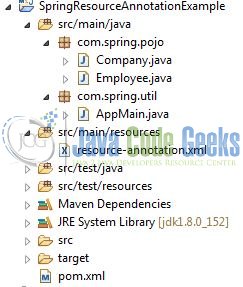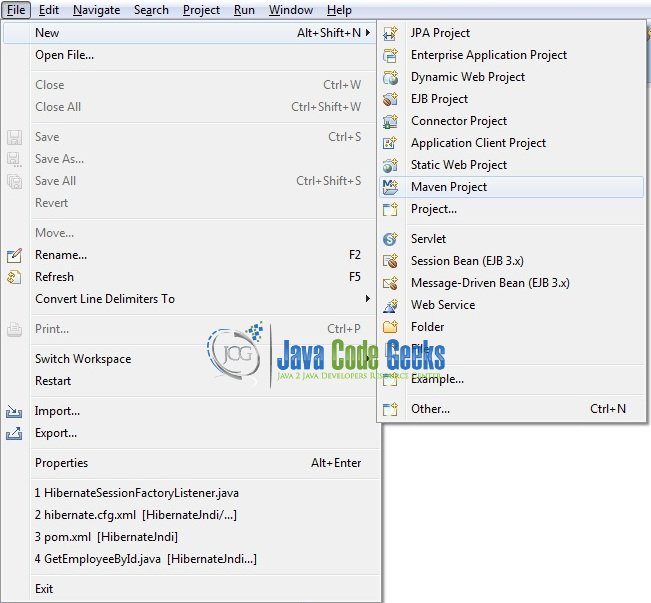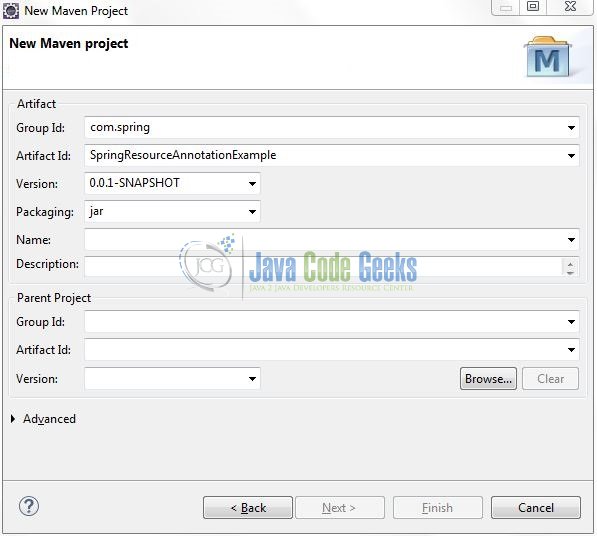Spring @Resource Annotation Example
JDK JSR-250 provides a property or method-level annotation that supports the Autowiring functionality in the spring framework. Spring supports this injection by using the @Resource annotation, applied to either the property or the setter method of a bean. This tutorial will explore the JDK-specific @Resource annotation in the spring.
1. Introduction
1.1 Spring Framework
- Spring is an open-source framework created to address the complexity of an enterprise application development
- One of the chief advantages of the Spring framework is its layered architecture, which allows the developer to be selective about which of its components they can use while providing a cohesive framework for
J2EEapplication development - Spring framework provides support and integration to various technologies for e.g.:
- Support for Transaction Management
- Support for interaction with the different databases
- Integration with the Object Relationship frameworks for e.g. Hibernate, iBatis etc
- Support for Dependency Injection which means all the required dependencies will be resolved with the help of containers
- Support for
RESTstyle web-services
1.2 @Resource annotation in spring
The @Resource annotation in spring performs the autowiring functionality. This annotation follows the autowire=byName semantics in the XML based configuration i.e. it takes the name attribute for the injection. Below snippet shows how to use this annotation.
Code Snippet
import javax.annotation.Resource;
public class Employee {
private String id;
private String name;
@Resource(name="mycompany")
private Company company;
…
}
This annotation takes an optional name argument. In case no name attribute is specified with this annotation, the default name is interpreted from the field-name or the setter method (i.e. the bean property name). Always remember that if the @Resource annotation doesn’t find the bean with the name it will automatically switch it’s autowiring technique to autowire=byType (i.e. @Autowired annotation).
1.2.1 Activate @Resource annotation
To activate this annotation in spring, developers will have to include the <context:annotation-config /> tag in the configuration file. Below snippet shows how to include this tag in the configuration file:
Code Snippet
<beans
//...
xmlns:context="http://www.springframework.org/schema/context"
//...
xsi:schemaLocation="http://www.springframework.org/schema/context
http://www.springframework.org/schema/context/spring-context.xsd">
<!-- To activate the @Required annotation in spring -->
<context:annotation-config />
</beans>
In addition, the same can also be achieved by specifying the bean definition of the CommonAnnotationBeanPostProcessor class in the configuration file. Below snippet shows how to include the object of this class in the configuration file:
Code Snippet
<beans xmlns="http://www.springframework.org/schema/beans"
xmlns:xsi="http://www.w3.org/2001/XMLSchema-instance"
xsi:schemaLocation="http://www.springframework.org/schema/beans
http://www.springframework.org/schema/beans/spring-beans.xsd">
<bean class="org.springframework.beans.factory.annotation.CommonAnnotationBeanPostProcessor"/>
</beans>
Now, open up the Eclipse IDE and let us see how to implement this annotation in the spring framework!
2. Spring @Resource Annotation Example
Here is a systematic guide for implementing this tutorial in the spring framework.
2.1 Tools Used
We are using Eclipse Kepler SR2, JDK 8, MySQL and Maven. Having said that, we have tested the code against JDK 1.7 and it works well.
2.2 Project Structure
Firstly, let us review the final project structure, in case you are confused about where you should create the corresponding files or folder later!

2.3 Project Creation
This section will demonstrate how to create a Java-based Maven project with Eclipse. In Eclipse IDE, go to File -> New -> Maven Project.

In the New Maven Project window, it will ask you to select project location. By default, ‘Use default workspace location’ will be selected. Select the ‘Create a simple project (skip archetype selection)’ checkbox and just click on next button to proceed.
It will ask you to ‘Enter the group and the artifact id for the project’. We will input the details as shown in the below image. The version number will be by default: 0.0.1-SNAPSHOT.
Click on Finish and the creation of a maven project is completed. If you observe, it has downloaded the maven dependencies and a pom.xml file will be created. It will have the following code:
pom.xml
<project xmlns="http://maven.apache.org/POM/4.0.0" xmlns:xsi="http://www.w3.org/2001/XMLSchema-instance" xsi:schemaLocation="http://maven.apache.org/POM/4.0.0 http://maven.apache.org/xsd/maven-4.0.0.xsd"> <modelVersion>4.0.0</modelVersion> <groupId>com.spring</groupId> <artifactId>SpringResourceAnnotationExample</artifactId> <version>0.0.1-SNAPSHOT</version> <packaging>jar</packaging> </project>
We can start adding the dependencies that developers want like Spring Core, Spring Context etc. Let us start building the application!
3. Application Building
Below are the steps involved in developing this application.
3.1 Maven Dependencies
Here, we specify the dependencies for the spring framework. Maven will automatically resolve the rest dependencies such as Spring Beans, Spring Core etc. The updated file will have the following code:
pom.xml
<project xmlns="http://maven.apache.org/POM/4.0.0" xmlns:xsi="http://www.w3.org/2001/XMLSchema-instance"
xsi:schemaLocation="http://maven.apache.org/POM/4.0.0 http://maven.apache.org/xsd/maven-4.0.0.xsd">
<modelVersion>4.0.0</modelVersion>
<groupId>com.spring</groupId>
<artifactId>SpringResourceAnnotationExample</artifactId>
<version>0.0.1-SNAPSHOT</version>
<dependencies>
<!-- https://mvnrepository.com/artifact/org.springframework/spring-beans -->
<dependency>
<groupId>org.springframework</groupId>
<artifactId>spring-beans</artifactId>
<version>5.0.8.RELEASE</version>
</dependency>
<!-- https://mvnrepository.com/artifact/org.springframework/spring-context -->
<dependency>
<groupId>org.springframework</groupId>
<artifactId>spring-context</artifactId>
<version>5.0.8.RELEASE</version>
</dependency>
</dependencies>
<build>
<finalName>${project.artifactId}</finalName>
</build>
</project>
3.2 Java Class Creation
Let us write the Java classes involved in this application.
3.2.1 Implementation of Company Model
This POJO class contains two properties to perform the byName autowiring. Add the following code to it:
Company.java
package com.spring.pojo;
public class Company {
private String name;
private String location;
public String getName() {
return name;
}
public void setName(String name) {
this.name = name;
}
public String getLocation() {
return location;
}
public void setLocation(String location) {
this.location = location;
}
@Override
public String toString() {
return "Company [name=" + name + ", location=" + location + "]";
}
}
3.2.2 Implementation of Employee Model
This POJO class contains three setter methods for demonstrating the use of @Resource annotation. Add the following code to it:
Employee.java
package com.spring.pojo;
import javax.annotation.Resource;
public class Employee {
private String id;
private String name;
@Resource(name="mycompany")
private Company company;
public String getId() {
return id;
}
public void setId(String id) {
this.id = id;
}
public String getName() {
return name;
}
public void setName(String name) {
this.name = name;
}
public Company getCompany() {
return company;
}
public void setCompany(Company company) {
this.company = company;
}
@Override
public String toString() {
return "Employee [id=" + id + ", name=" + name + ", company=" + company.toString() + "]";
}
}
3.2.3 Implementation of Utility Class
The implementation class will get the bean definition from the context file and demonstrate the use of @Resource annotation in the spring framework. Add the following code to it:
AppMain.java
package com.spring.util;
import org.springframework.context.ApplicationContext;
import org.springframework.context.support.ClassPathXmlApplicationContext;
import com.spring.pojo.Employee;
public class AppMain {
@SuppressWarnings("resource")
public static void main(String[] args) {
ApplicationContext ac = new ClassPathXmlApplicationContext("resource-annotation.xml");
Employee emp = ac.getBean("myemployee", Employee.class);
System.out.println(emp.toString());
}
}
3.3 Configuration Files
Let us write all the configuration files involved in this tutorial.
3.3.1 Resource
A typical bean configuration file for understanding the @Resource annotation will look like this:
resource-annotation.xml
<?xml version="1.0" encoding="UTF-8"?>
<beans xmlns="http://www.springframework.org/schema/beans"
xmlns:xsi="http://www.w3.org/2001/XMLSchema-instance" xmlns:context="http://www.springframework.org/schema/context"
xsi:schemaLocation="
http://www.springframework.org/schema/beans http://www.springframework.org/schema/beans/spring-beans.xsd
http://www.springframework.org/schema/context http://www.springframework.org/schema/context/spring-context.xsd">
<!-- To activate the '@Resource' annotation in the spring framework -->
<context:annotation-config />
<bean id="mycompany" class="com.spring.pojo.Company">
<property name="name" value="Test Pvt. Ltd." />
<property name="location" value="India" />
</bean>
<bean id="myemployee" class="com.spring.pojo.Employee">
<property name="id" value="123456" />
<property name="name" value="Charlotte O' Neil" />
</bean>
</beans>
4. Run the Application
To execute the application, right click on the AppMain class, Run As -> Java Application. Users can debug the example and see what happens after every step. Enjoy!
5. Project Demo
When users will run this tutorial, they will get the following logs as output.
Output Logs
Sep 10, 2018 11:51:14 AM org.springframework.context.support.AbstractApplicationContext prepareRefresh INFO: Refreshing org.springframework.context.support.ClassPathXmlApplicationContext@bebdb06: startup date [Mon Sep 10 11:51:13 IST 2018]; root of context hierarchy Sep 10, 2018 11:51:15 AM org.springframework.beans.factory.xml.XmlBeanDefinitionReader loadBeanDefinitions INFO: Loading XML bean definitions from class path resource [resource-annotation.xml] Employee [id=123456, name=Charlotte O' Neil, company=Company [name=Test Pvt. Ltd., location=India]]
That is all for this tutorial and I hope the article served you whatever you were looking for. Happy Learning and do not forget to share!
6. Conclusion
This post defines the @Resource annotation in the spring framework and helps developers understand the basic configuration required to achieve this. Developers can download the sample application as an Eclipse project in the Downloads section.
7. Download the Eclipse Project
This was an example of Spring @Resource Annotation.
You can download the full source code of this example here: SpringResourceAnnotationExample






